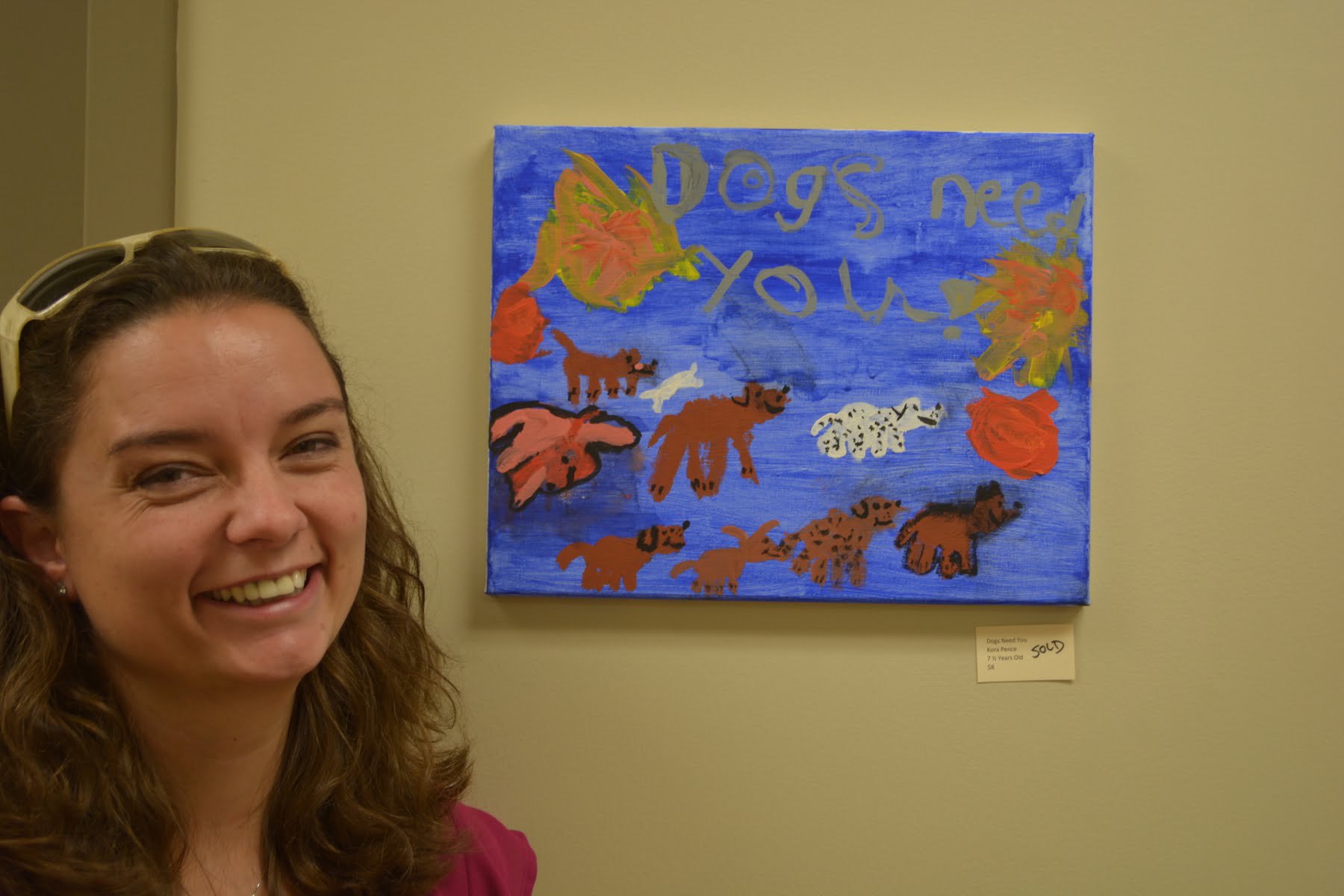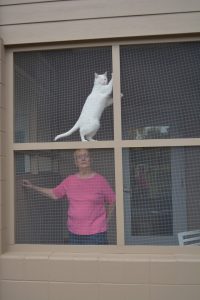
Montgomery County Animal Care and Adoption Center Director, Eileen Mahan, stands next to a painting that says “Dogs need you” by an 8-year-old animal advocate (for sale, artist’s suggest price $8). Art throughout the center is part of Mahan’s community outreach
Research-backed architecture transformed Montgomery County’s dog pound into its animal care and adoption center.
Liz Kirchner
communitynews@ourvalley.org
Two weeks ago, animal shelter volunteers gathered to witness the demolition of Montgomery County’s old shelter and, with it, the outdated animal-care notion the building represented.
Dirty, cold, hot, dark and loud was how volunteers remembered the old building that day as they watched a back-hoe trundle down the length of the cinderblock cells and rusted chain link, raise its heavy claw and smash the roof in a spray of plywood and shingle.
The crowd of volunteers, staff and county administrators standing on a grassy knoll at the new center to witness the event cheered. When someone yelled, “that was the euthanasia room!” they cheered louder.
The old animal shelter served Montgomery County since the 70s principally as a place to put lost and abandoned dogs waiting for reunion with their owner or adoption.
But the grimy, noisy sheds stuffed with lonely, scared dogs, wasn’t a real draw. “People would say, ‘I can’t go there. It’s just too sad,’” explained Jennifer Harris, Public Information Director for Montgomery County.
At the demolition ceremony on that grassy knoll, in a heavy grey vest with “Animal Control Officer” stamped on the back in large black font, a woman is standing with the volunteers, some laughing, but some crying. She explains that it’s bittersweet to watch the old building come down.
“We were all in the trenches together in that building. Collectively duct-taping things together,” she said. “We were a close unit. We all have memories.”
Volunteers and staff, their ingenuity and dedication, worked around the building’s design flaws, but American Society for the Prevention of Cruelty to Animals data suggest that the building itself represented a time when no amount of duct-tape could patch an institutional indifference to companion animal care.
The ASPCA estimates that in 2001, 2.6 million dogs and cats were euthanized in U.S. shelters, but its data also shows that, by 2017, the number has nearly halved.
The decline, said the ASPCA, can be partially explained by an increase in the percentage of animals adopted — people are no longer saying, “I can’t go to the pound, it’s just too sad” — as well as an increase in the number of stray animals successfully returned to their owners.
Happy to lead a tour of the new building, Eileen Mahan, brown hair and naturally pretty, is a youthful 35, which is surprising for someone who brings an ecology of animal-care knowledge with her as director of the center. With a degree in Zoology work as a Nature Interpreter in Virginia parks, she has also been an animal control officer, seeing the system from all sides.
She leads us in. The center has all the calm pastels, clean windows and high, light-filled space of a yoga studio, a clinic or an elementary school. It’s quiet, smells nice and the pale walls are lined with bright splashes of art — dogs and cats sketched by local Honeysuckle Studios, then painted by the pet’s owner on Paint Your Pet Night –– just one of the community outreach and education events built into the center.
When Mahan is in the lobby Monday afternoon, someone brought in an abandoned kitten.
“My neighbor just threw ‘em out,” the woman said.
The kitten was black and white with milky, just-opened eyes.
“I couldn’t find the other one,” the concerned woman explained. “There was another one.”

The volunteers in green T-shirts gathered around to help. Perhaps from years in the trenches of the old shelter, volunteer care is creative. It’s not unusual for volunteers s to fashion makeshift slings for newborn kittens who need warmth and bonding carrying the kitten against their bodies as they work.
Special help is given to old cats who need baths after eating and a dog, blinded early in life was given extra care until a local company donated an experimental clicking sonar collar and the freedom of movement the dog had never had.
As the tour continues, it’s clear, the building itself is kind too. The county worked with Shelter Planners of America, which designs shelters all across the country, finishing the needs assessment, feasibility and building program study in 2009.
The design considered all involved.
“The goal is to make sure that it isn’t just pleasing for the citizens that come in to look at animals,” Mahan said. “But for the animals to live there as well.”
The tour began as many of the animals do, at the dedicated intake area – where people bring their pets to hand them over and say good-bye. The room is small and separate, away from the lobby full of happy adoptions and welcomings.
“That’s important for the citizens because when they need to come in and surrender an animal to us, it can often be very emotional. So we have this space to respect those emotions,” Mahan explained.
“Clean” is the first impression as we walk down the shiny hall passing the animal-receiving room full of stainless steel tubs, hoses and kennels. Usually the most hectic room, the receiving room is where animals come in first and where everything happens all at once.
When a lost or abandoned animal arrives. It gets water, a basic exam and a quick check for fleas and wounds. “
“We didn’t have this at the old facility, so the animals that came in, we were doing it in the office. On our desks looking for fleas.”
Grants from Petco now support preventative care, flea and tick care and wormers, that can be administered as soon as an animal arrives,
“So they can start to feel better quick,” Mahan said.
Litter and food comes from community donations.
“We are blessed by our responsive community,” she said
There are separate rooms for newly arrived stray dogs, away from the barking and confusion of a bigger kennel. Some have tags or chips and may be waiting for owners.
At the doors of each kennel, a counterweight (cleverly shaped like a bone) lifts and closes doors quietly – no more clanging. There’s lots of barking though, as the tour comes through. The dogs being passed in well-lit kennels wag tails. Long-legged coonhounds (there were at least two) leap straight up to great the guests, belling like they’ve tree’d them, a Chihuahua-mix boings on his trampoline bed. Tails are whipping lickety-split. The tour emerged into the hall, a calm, creamy tan. It’s surprisingly quiet and surprisingly shiny. It’s epoxy, not the disease-sopping concrete.
Mahan opened a metal box set into the wall full of hose connectors and valves. “This has been a game changer,” she said. The cleaning system is built right into the walls. Hoses and pressure washers plug right in throughout the building, automatically mixing the chemical spray to clean and sanitize.
“It has high and low pressure so we can get all the kennels cleaned fast. And you’re not worried about getting the mix right,” she said. “Just being able to properly sanitize and having the floors and things that don’t absorb disease. That’s a big thing.”
Like stress-reduction and community participation, sanitation is an overarching driver of the building’s design.
“If we can keep stuff sanitized, we can prevent disease. When animals come in, it can be very stressful,” Mahan said. “Stress by itself can cause disease. Like when you are stressed, you’re more likely to get a cold. Anything we can do to limit stress, limits disease, which limits stress.”
There are drains in every cage. It used to be, hosing out a kennel, a trough in front of the runs would carry the waste.
“You had to spray everything out and then it would run by everybody else’s cage. As you can imagine for disease control that wasn’t so great,” the director explained.
Now each cage has its own drain.
The tour led to the bathing room and the laundry area. Mahan said that caring for a puppy is like caring for a three-year-old child, they need lots of patience and gentle, reliable, friendly help. An older dog is like a seven-year-old.
“You still have to feed them, but they can tell you when they need things,” she said.
The group continued down the adoption hall lined with windows full of cats – 68 today. With no room to spare, the old shelter did not take cats. Windows look out to the green courtyard. Each cat has a cage with a separate, ventilated space for the litter box.
“That ventilation not only controls smell, but it’s huge for disease control. Cats in a cattery like this can get upper respiratory diseases, and if they can’t smell, they won’t eat.
In larger rooms, kittens yowl and clamber and sleep on poufs, towers, and ladders. An enormous hamster wheel entertains and exercises the kittens galloping and tumbling. Mahan hopes to install a real-time camera to film their shenanigans for the community.
A large white cat named Blizzard meows at us alone in a sunny room. His sister, Angel, and his brother, Oatmeal, were adopted over the weekend. Mahan said that posting the pictures of animals in the News Messenger and Radford News journal has increased adoption rates.
“Pet-of-the-Week in the paper has been really helpful,” Mahan said.
A volunteer, Christiansburg resident, Anna Patty, arrives to care for the white cat and keep him company. They go out into the screened ‘catio’ for some air and climbing.
The tour concludes in the lobby. The kitten brought in that morning is now swaddled in a towel, being fed with an eyedropper. Regarding abandoned kittens, Patty is asked, “so, how do you feel about that?”
“Well, we have good days and bad days, and that’s how it is. You have days when you have an impact in the community and you can see it and you can feel it and you go home and you say, ‘Yeah’. And then we have rough days when we bring in 16 cats or kittens and most of them are sick and we have to take them to the vet. It’s a bit of a roller-coaster ride, but we do it because we have more good outcomes than we do bad,” she responded.
The county launched plans for the new building 20 years ago. The facility, with its hoses and drains, its catios and live-feed kitten cams and kennel doors that don’t clang, embodies transformations both solid and intangible. The 300 percent increase in space for dogs and cats, the 55 percent increase in hours of operation are solid, and events as sweet as Paint your Pet Night, and obedience training and pet care classes are just as important.
Three hundred and fourteen animals have found homes since April, in the old building, only 203 dogs were adopted in the entire year of 2015.
The Animal Care and Adoption Center is open from 11 a.m.-6 p.m. Monday-Friday and 11 a.m.-4 p.m. Saturday and Sunday.
For more information, visit www.montgomerycountyva.gov/acac, The ASPCA, www.aspca.org, and Honeysuckle Studios, part of Paint Your Pet Night, www.honeysucklestudio.com.



